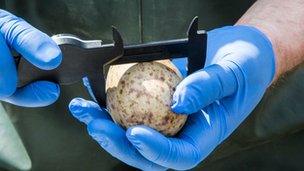First crane egg in 400 years laid at Slimbridge
- Published

The nesting pair can be watched from hides at WWT Slimbridge
The first crane egg in southern Britain in more than 400 years has been laid by a nesting bird.
The Great Crane Project has been rearing cranes and reintroducing them to the West Country since 2010.
The egg, the first from cranes released by the project, is under round-the-clock guard at the Wildfowl and Wetlands Trust (WWT) at Slimbridge, Gloucestershire.
Hunting and the loss of wetlands led to cranes becoming extinct in Britain.
The trust has been rearing them in captivity and the oldest of the cranes released by the project only reached maturity this year.
The nesting pair can be watched from hides at WWT Slimbridge.
'Absolutely momentous'
A long lens video link has also been set up to give visitors to Slimbridge and its website a close-up view.
The surveillance cameras record footage so it can be reviewed at a later date providing a resource for conservation scientists.
They also help the guards protecting the nest from egg collectors.
WWT's Nigel Jarrett said: "Cranes are an iconic part of British wildlife and one that was all but lost for centuries.
"There is a long way to go before cranes become widespread again, but it is absolutely momentous to see this egg laid at Slimbridge.
"The Great Crane Project has brought together diverse skills: breeding and rearing birds, creating wetland habitats and engaging people in conservation.
"The parents of this egg were hand-reared here at Slimbridge and have thrived through their first three years on the wetlands of the Somerset Moors, thanks to the help and support of the local community, particularly the farmers."
In the 1980s, a tiny group of cranes established home in Norfolk. But the population there has struggled to survive, barely reaching anything like sustainable numbers.
- Published3 April 2013
- Published15 May 2012
- Published21 April 2011
- Published10 November 2010
- Published28 April 2010